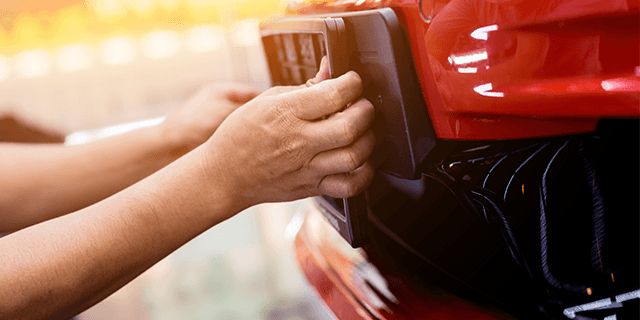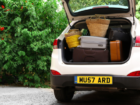How does the UK licence plate system work, and what do all the letters and numbers mean? We decode the number plate system
Every car on the roads in the UK must display a number plate – also known as a registration plate or, for the Americans, a licence plate. This unique combination of letters and numbers serves as a means of identifying the car, much like a driving licence identifies the car’s driver.
Number plates are issued and tracked by the Driver and Vehicle Licencing Agency (DVLA) and serve as a unique code that can be used to access certain information about a car or its driver. That’s everything from councils issuing parking fines, to police tracking stolen vehicles – or even checking the MOT history of a vehicle you’re planning on buying.
But what do the individual letters and numbers mean, and how do you ‘read’ a current British number plate?
How do registration plates work?
The current number plate system in the UK was introduced in 2001 and is arranged in a set format of two letters, followed by two numbers, followed by three more letters. These figures are displayed on both the front and rear of the car – in a white plate on the front and a yellow plate at the back. They can be square or rectangular.
The first two letters:
- The first two letters are an area identifier and show where the vehicle was registered. For example, plates starting with BA through to BY were registered in the Birmingham region, while VA to VY covers those registered in the Severn Valley. A full list of these is available here.
The two numbers:
- The two numbers serve as an age identifier, and refer to a six-month period in which the car was registered. These periods run from March to August, or September to February, changing on March 1 and September 1 every year.
- The March codes follow the year of the registration – for example, a vehicle registered in March 2017 will have the number 17.
- For cars registered from September to February, the code is the year plus 50 – so a car registered in September 2017 will have the number 67.
The last three characters:
- The last three letters of your vehicle’s registration plate are the only ones that don’t mean anything. They’re randomly generated.
- The last three letters are the only place you’ll find a ‘Z’ in a registration plate too; ‘Z’ is never used in local memory tags.
The table below shows how the numbers relate to the year
| Car Reg Year | 1 March to end August | 1 September to end February |
| 2001-2002 | – | 51 |
| 2002-2003 | 02 | 52 |
| 2003-2004 | 03 | 53 |
| 2004-2005 | 04 | 54 |
| 2005-2006 | 05 | 55 |
| 2006-2007 | 06 | 56 |
| 2007-2008 | 07 | 57 |
| 2008-2009 | 08 | 58 |
| 2009-2010 | 09 | 59 |
| 2010-2011 | 10 | 60 |
| 2011-2012 | 11 | 61 |
| 2012-2013 | 12 | 62 |
| 2013-2014 | 13 | 63 |
| 2014-2015 | 14 | 64 |
| 2015-2016 | 15 | 65 |
| 2016-2017 | 16 | 66 |
| 2017-2018 | 17 | 67 |
| 2018-2019 | 18 | 68 |
| 2019-2020 | 19 | 69 |
| 2020-2021 | 20 | 70 |
| 2021-2022 | 21 | 71 |
For older number plates with the prefix and suffix system, head to our What year is my car page for a handy table showing what was used when.
Vehicle sales typically peak as the number plates change, leading to a surge in vehicle sales around March and September each year. If you’re hunting for a bargain, search just before these periods – where dealers will want to clear as much of their inventory as possible with an ‘old’ number plate on.
What else is on a number plate?
Number plates may also display a country flag – the Union flag, the St George Cross, the St Andrew Cross or the red dragon of Wales. These can be paired with letters identifying the country in question.
Before Brexit, vehicles that displayed both ‘GB’ and the Union flag of the EU did not need to display a separate ‘GB’ sticker on their car while travelling abroad, however this is no longer the case making its addition purely ornamental.
From the end of 2020, electric cars were permitted to display a green square on the left of the number plate, identifying them as zero-emissions.
What about personal number plates?
The rules for personalised number plates are more complex and we’ve explained them in detail here – but generally, anything goes on a private number plate as long as it is legible and not obscene.
So-called ‘cherished’ number plates are typically available to purchase from specific number plate dealers, who can track down the plate you’re looking for.
What can I do with a UK registration plate?
Number plates are useful pieces of information to have, and they come into their own if you’re buying or selling a car. Armed with a number plate, you can get a rough valuation for a car, to make sure you’re paying or charging a fair price.
You can also check a vehicle’s MOT status and history on the Gov.UK website to be sure it doesn’t have a hidden past you’re not aware of. It’s also a good idea to do an HPI check to warn of outstanding finance or vehicle write-offs.
Just as usefully, use a car number plate to get quotes for and to insure a vehicle – which you can do right here on mustard.co.uk.
Can you keep an old registration plate?
If you need to scrap an old vehicle you can keep the registration plate but if it’s a standard plate you can’t use it on your next vehicle.
If you own a private number plate you can transfer it to your new vehicle online or by post through the DVLA, and it’s free.
For a list of all recommended automotive parts and accessories, you can visit Amazon Automotive.








